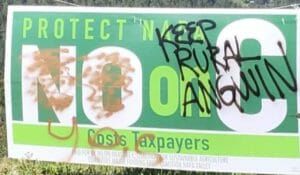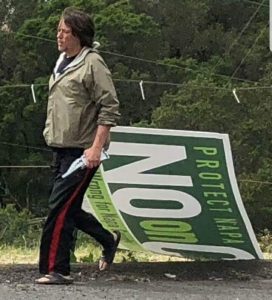 Vandalism was a common sight on these signs. With the exception of some of Napa’s diehards, my guess is that June 5th’s Measure C wasn’t a major concern amongst voters on this year’s ballot. However, for those of us that live and/or work in Napa Valley, it was a dividing line amongst neighbors. We had to choose if we fell under the category of environmentalist or agriculturalist. Driving along Highway 29, signs that read “Yes on C” and “No on C” sprinkled fences with competing slogans that urged you to protect the environment or protect Napa. These same signs were vandalized and stolen from private properties, Facebook arguments ensued, and friendships amongst neighbors were broken.  This picture was taken just after this sign was taken down. As a self-proclaimed environmentalist, when I first heard about Measure C, it seemed like a simple choice to support the measure, and when the Napa Valley Vintners originally named their support for the measure, I figured I’d follow their lead without looking into it too much. As it turns out, this blind following of an association I’m part of is not the best way to inform your ballot. So, even while every other Napa organization opposed it (the Winegrowers, Farm Bureau, Grapegrowers, Coalition, and Sustainable Napa County), I didn’t do much digging on the measure at the time. However, when the Napa Valley Vintners changed their stance last October, it prompted me to read the fine print, revealing that the measure was not just about “protecting the environment.” Measure C was written by concerned residents and environmentalists, Mike Hackett, an ex-Navy pilot, and Jim Wilson, who holds a Bachelor of Science in Food Science from UC Davis. Without the aid of any natural resource or forestry consultants, Mike and Jim set very specific, yet arbitrary quantities for the amount of acres that Napa County could remove before the measure would restrict all further oak woodland removal. According to Mike Hackett, he named 795 acres as “a reasonable restriction” according to www.protectnapawatersheds.org. Another example of a seemingly arbitrary number placed in the measure is in Section 18.20.050 & 18.20.060 which stated that you’d get a misdemeanor if you were to cut an oak tree on your property that was 5 inches or larger in diameter and if caught doing so you could be “subject to any and all available judicial and administrative enforcement actions.” Again, it’s not clear where they came up with this metric. The arbitrary numbers brought up a lot of questions for those of us that these new rules would impact. Why is the diameter limit set at 5 inches and not 6″ or 12″? After all, a misdemeanor is pretty serious, right? Shouldn’t experts be in charge for that type of legislation instead of concerned citizens and lawyers? Additionally, it was unclear how last year’s historically devastating fires (where over 30,000 acres were burnt in the agricultural watershed zone) would impact the interpretation of the acreage and how the numbers would be calculated. Would the burnt acreage account for part of the 795 acres in the measure? Napa’s history is already full of restrictions and rules for land use. In 1968, the revolutionary AgPreserve was introduced with an environmental purpose of preservation, hence why only 9% of Napa Valley is planted today. In 1990, Measure J was implemented which further regulated Napa Valley, protecting Napa County’s water supply and oak woodlands. Today, if one wanted to plant new vines on recently acquired Napa land, one would have to wait 2 years minimum for the proper permit to get approved…not to mention hire an engineer to write the plan, hire a surveyor for the engineer, hire a biologist to make sure there’s no rare endangered species, hire an archaeologist to ensure there’s no Native American burial ground, etc. In other words, it’s a long and arduous process. That’s because Napa is the most highly regulated wine region in the world. So why would we need more regulation? Why find a solution to a problem that doesn’t really exist? After all, there was zero scientific evidence or research that Measure C would improve the water quality or further protect Napa’s environment. Had Measure C passed, it would’ve landlocked Napa further, in effect, increasing the value of Napa grapes and land. Inevitably, this would’ve made the “already-established” richer while pricing out the small farmers and wineries that already struggle to survive. This was the main factor for me. In 2015, I bought ultra premium Oakville Cabernet Sauvignon and Cabernet Franc (between Harlan and Bond). I had waited 4 years on a wait-list for this fruit, and after pestering the vineyard owner every year for it, I was finally going to get it. I was beyond thrilled, and was in talks of a long-term contract with the owner. When another winery heard I was going to buy that fruit, they offered the owner 3 times what I had originally agreed to. The owner revoked his original offer to me, and I pleaded my case stating that it was an unethical business practice if he were to deny me that fruit after everything that had happened.  The aforementioned Oakville vineyard. I eventually got that fruit, but it was a one-off, crushing any hopes of an evergreen opportunity. As a small fish in an ever-rising ocean (where one Howell Mountain winery owner once told me, “I’ll sell you my grapes, even though you’re a nobody.”), this anecdote only illustrates the type of dog-eat-dog world Napa was 3 years ago, and it’s only gotten worse! In the past 4 years, the numbers of wineries in Napa have nearly doubled (from around 450 to almost 900). The grape prices I source have escalated 33% in the past 5 years. By exponentially increasing grape prices, Measure C would have undoubtedly increased bottle prices too–a very common complaint by consumers. The good news is that the informed voters of Napa must have done their homework too. Now that Measure C has been defeated (by a narrow 641 votes, just 0.9%), I’m grateful I’ll be seeing more vineyards on the hillsides rather than mansions, and these vineyards will act as firebreaks should there be more fires in the future. I’m grateful for the opportunity to get to continue pursuing my passion, even if I’m still a “nobody” in comparison to those that are more established in Napa. Finally, I’m grateful for the community of Napa that stands behind one another during tough times. While I recognize that others may have different opinions and views on the topic of Measure C, I’m hopeful in moving forward that there is space in the vineyards for both the legends and the future of Napa Valley. |
